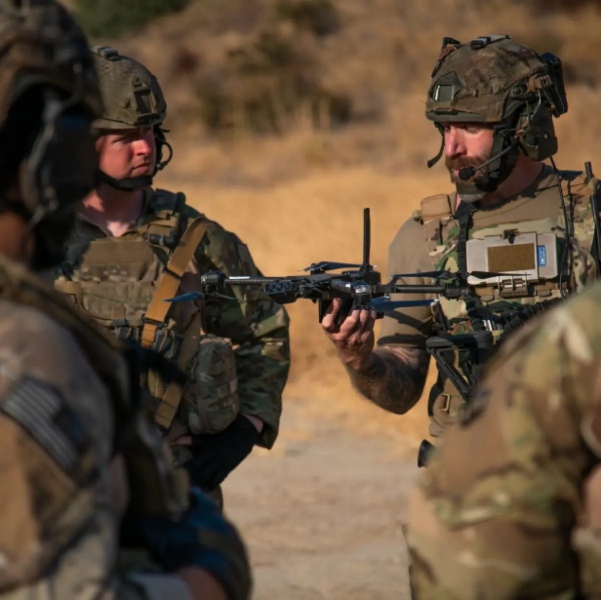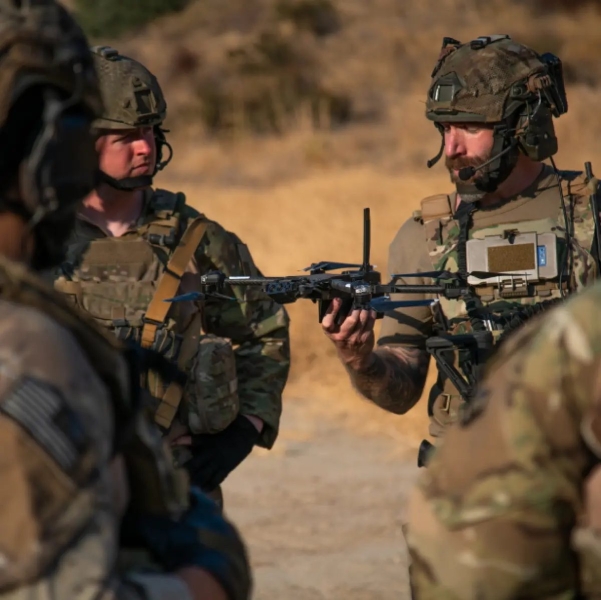Congress Moves to Fast-Track U.S. Military Drone Production and Exports: LEAD Act
Laws proposed to encourage production, export of drones for defense
By DRONELIFE Features Editor Jim Magill
Federal lawmakers have introduced legislation that would make it easier to produce U.S.-made drones for the Department of Defense (DOD) and to export military drones produced in the United States to friendly countries.
A bipartisan bill, the Leading Exports of Aerial Drones Act, or LEAD Act, would reclassify unmanned aerial systems bound for export, so they are regulated in the same way as manned aircraft, rather than as missile technology as they are under the current regulatory regime. Proponents of the legislation say this would greatly speed up the process for exporting American-made drones to U.S. Allies.
The bill introduced by Republican Senators Tom Cotton of Arkansas and John Cornyn of Texas and Democrat Chris Coons of Delaware is one of several efforts by legislators to promote the U.S. “drone dominance” called for by the Trump administration.
What’s in LEAD Act Drone Legislation?
“The bill allows U.S.-made drones to be exported to our military allies using the same strict process already in place for exporting U.S. military aircraft like the F-16,” Cotton said in an email statement in response to questions posed by DroneLife. “Under outdated laws, based on the 1980s era Missile Technology Control Regime agreement, drones are treated identically to missiles when they should really be treated like aircraft.”
He said that updating the export regulations would enable U.S. allies to more easily buy American-made drones, “which will both boost our domestic drone-making industry and put an end to China’s dominance of the global drone market.”
The regulatory change would also create an incentive for American UAV manufacturers and drone industry investors to expand the capacity to produce drones and systems not just for use by the U.S. Department of Defense, but for the use of our allied governments as well, Cotton said.
Approvals for military exports can take up to four or five years, making it difficult for allied nations to buy the latest drone technology produced in the U.S.
“As innovation moves quickly, especially in conflicts like Ukraine, we risk falling behind. By cutting outdated red tape, we can speed up approvals, strengthen our defense industry, and help U.S. manufacturers lead in the global drone market,” he said.
Cotton said Congress could take other steps to achieve the goal of creating U.S. drone dominance.
“Congress can support the drone industry further by investing in tools like drones that help our men and women in uniform on the battlefield,” he said. He pointed to the 184th Attack Squadron based in Fort Smith, Arkansas, which boasts the title of top Remotely Piloted Aircraft Squadron across all U.S. Air Force active duty, National Guard and Reserve units.
“By investing resources in these units and the men and women who staff them, American drone technology can continue to be the envy of the world,” Cotton said.
Congressman Ryan Zinke, a Montana Republican who is sponsoring the companion legislation in the House of Representatives, said the LEAD Act would streamline U.S. military drone exports, improve interoperability, and increase the demand for American-made drones, which would strengthen domestic production.
“However, barriers like complex export regulations, supply chain issues, and bureaucratic delays still limit U.S. dominance in drone manufacturing,” Zinke said in an email statement.
Zinke, who serves as chairman of the House Foreign Affairs Foreign Military Sales Task Force, said he is also pursuing broader reforms to the arms sale process to improve efficiency and support the growth of U.S.-based defense industries.
The proposed LEAD Act is just one way in which the federal government is moving toward promoting a robust domestic drone industry, particularly in regard to encouraging the accelerated production of UAVs used for military purposes.
In June, President Trump issued two executive orders aimed at kick-starting U.S. based drone production. One of those documents, “Unleashing American Drone Dominance,” focused in large part on making it easier for domestic drone producers to manufacture UAVs for the DOD and for export to allied nations.
Last month, Secretary of Defense Pete Hegseth issued a memorandum for senior Pentagon leadership, “Unleashing U.S. Military Drone Dominance.” The memo instructed military leaders to “bolster the nascent U.S. drone manufacturing base by approving hundreds of American products for purchase by our military.
In addition, Hegseth called for military leaders to arm “combat units with a variety of low-cost drones made by America’s world-leading engineers and AI experts,” and to incorporate drone technology “into all relevant combat training, including force-on-force drone wars.”
Besides the Lead Act, Republican Senator Ted Cruz of Texas recently joined Senator Cornyn, Cotton and John Boozman of Arkansas to introduce the SkyFoundry Act of 2025 to establish drone research and production facilities at the Red River Army Depot in Texarkana, Texas. The bill would make it possible for private drone manufactures to develop and produce a million drones annually for the DOD.
The proposed legislation calls for the establishment of two government-owned facilities, one focused on innovationand another dedicated to production of small UAS. The innovation facility would be operated by the U.S. Army Materiel Command in co-ordination with U.S. Futures Command and would serve as the research, development and testing hub for new drone technology, integrating lessons learned from global conflicts such as the wars in Ukraine and the Middle East.
Once established, the production facility would be operated by U.S Army Materiel Command and would be capable of producing numerous different types of drones for use by the DOD.
The bill is written in such a way that the selection of sites for the two facilities is narrowed down to the Red River Army Depot. It calls for the facilities to be housed at an existing 15,000-acre Army depot with approximately 10,000 buildable acres of land and approximately 8,000,000 square feet of facilities. In addition, the depot is required to be located within 50 miles of four states — all qualifications that fit the Texarkana location.


